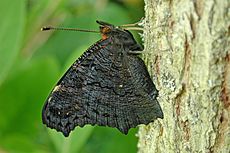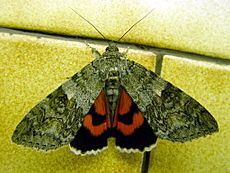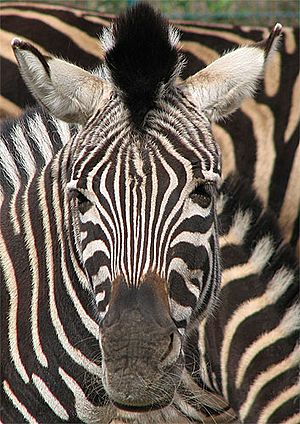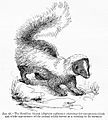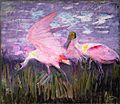Animal colour facts for kids
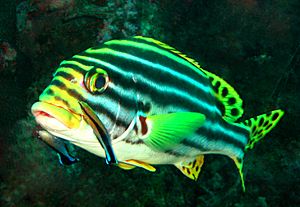
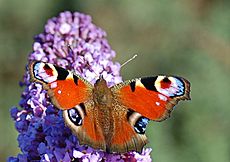
Animal colour (or coloration) is produced by light reflecting from an animal's surface. The ways animals produce colours include pigments, chromatophores and other structures, and bioluminescence.
Since sight is usually so important to animals, and is so often used by predators as a long-range way to find prey, an animal's colour must serve one or more functions. These functions, such as finding prey, or evading capture, or finding a mate, are absolutely essential for life and survival. Therefore, animal colour is determined by natural selection because it affects the survival of animals and their offspring.
Some of the most obvious functions of colour are:
- Camouflage: enabling an animal to remain hidden from view
- Signalling to other animals
- Warning colouration: signalling to other animals not to attack
- Mimicry: taking advantage of another species' warning coloration
- Sexual selection: finding a mate
- Other kinds of signalling
- Diversion
- Startle defence: unexpected flashes of colour or eyespots
- Dazzle: confusing a predator by moving a bold pattern (such as zebra stripes) rapidly
- Physical protection: such as humans in tropical climates have dark skin pigments which protect against sunburn and skin cancer.
- Incidental colouration. This is common in plants, which have green leaves because chlorophyll is green. In animals it is rare, such as having red blood (haem, needed to carry oxygen, is red). However, when the red shows on the surface it is often due to selection, as in human red lips.
Overwhelmingly, the most common function of colour is in predator-prey relationships. "Anti-predator adaptations occur in every biome of the world and in almost every taxonomic group".
Animal colour has been a topic of interest and research in biology for a long time. According to Charles Darwin's 1859 theory of natural selection, features such as colouration evolved by providing individual animals with a reproductive advantage. For example, individuals with slightly better camouflage than others of the same species would, on average, leave more offspring.
Startle and dazzle defences
Animals can have a camouflage defence at distance, but when faced by a predator they may switch to a 'flash' defence to gain time and distract the predator. The predator often blinks or turns its face away in self-defence. This is a reflex act which is there to protect its vital facial area. In the second the predator blinks, the prey flies or jumps, and lands in camouflage again. This pattern of colour plus behaviour is quite common. It is called deimatic defence by textbooks, from the Greek for 'dread' or 'to frighten'.
Related pages
Images for kids
-
Robert Hooke's Micrographia
-
Warning coloration of the skunk in Edward Bagnall Poulton's The Colours of Animals, 1890
-
In Roseate Spoonbills 1905–1909, Abbott Handerson Thayer tried to show that even the bright pink of these conspicuous birds had a cryptic function.
-
A flower mantis, Hymenopus coronatus, uses special Aggressive mimicry.
-
Cleaner wrasse signals its cleaning services to a big eye squirrelfish
-
A venomous coral snake uses bright colours to warn off potential predators.
-
The black and yellow warning colours of the cinnabar moth caterpillar, Tyria jacobaeae, are instinctively avoided by some birds.
-
The hawk-cuckoo resembles a predatory shikra, giving the cuckoo time to lay eggs in a songbird's nest unnoticed
-
A praying mantis in deimatic or threat pose displays conspicuous patches of colour to startle potential predators. This is not warning coloration as the insect is palatable.
-
The olm's blood makes it appear pink.
-
Side of zebrafish shows how chromatophores (dark spots) respond to 24 hours in dark (above) or light (below).
-
The red pigment in a flamingo's plumage comes from its diet of shrimps, which get it from microscopic algae.
-
Squid chromatophores appear as black, brown, reddish and pink areas in this micrograph.
-
The brilliant iridescent colours of the peacock's tail feathers are created by Structural coloration.
-
A Euplokamis comb jelly is bioluminescent.
See also
 In Spanish: Coloración animal para niños
In Spanish: Coloración animal para niños


